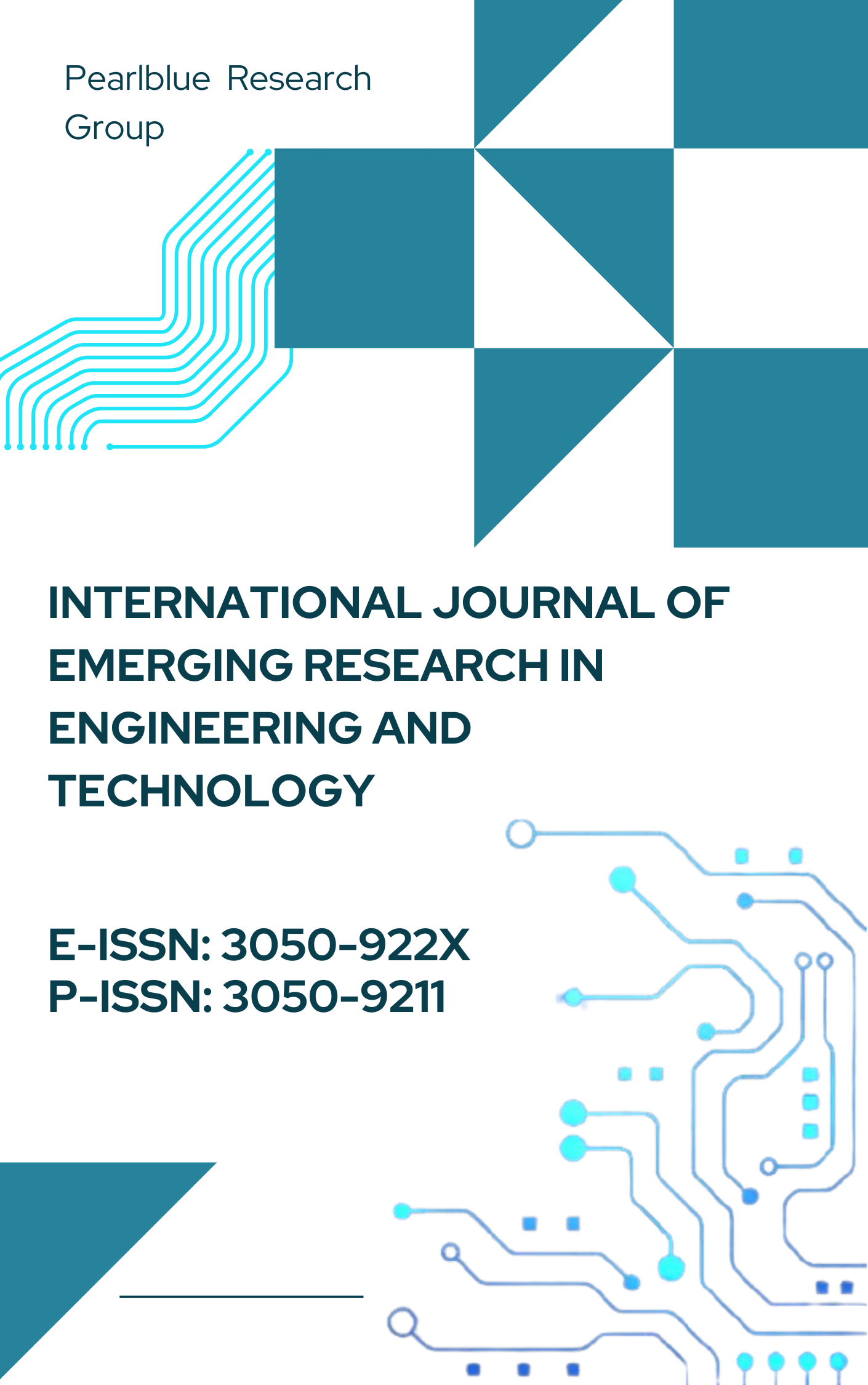Neural Network-Based Predictive Models for Healthcare Diagnostics: Current Trends, Techniques, and Challenges
DOI:
https://doi.org/10.63282/3050-922X.IJERET-V3I4P103Keywords:
Neural networks, healthcare diagnostics, data quality, interpretability, explainability, ethical considerations, data privacy, security measures, AI-driven analytics, predictive modelingAbstract
Neural network-based predictive models have revolutionized the field of healthcare diagnostics by offering advanced capabilities in disease prediction, early diagnosis, and personalized treatment plans. This paper provides a comprehensive review of the current trends, techniques, and challenges associated with the application of neural networks in healthcare diagnostics. We begin by discussing the fundamental concepts of neural networks and their evolution in the healthcare domain. We then delve into various neural network architectures, including feedforward networks, Convolutional Neural Networks (CNNs), Recurrent Neural Networks (RNNs), and Generative Adversarial Networks (GANs), and their specific applications in healthcare. The paper also explores the integration of neural networks with other machine learning techniques and data sources, such as Electronic Health Records (EHRs) and medical imaging. We highlight key case studies and empirical results to illustrate the effectiveness of these models. Finally, we discuss the challenges and future directions, including ethical considerations, data privacy, and the need for robust validation and regulatory frameworks
References
[1] LeCun, Y., Bengio, Y., & Hinton, G. (2015). Deep learning. Nature, 521(7553), 436-444.
[2] Esteva, A., Kuprel, B., Novoa, R. A., Ko, J., Swetter, S. M., Blau, H. M., & Thrun, S. (2017). Dermatologist-level classification of skin cancer with deep neural networks. Nature, 542(7639), 115-118.
[3] Rajkomar, A., Oren, E., Chen, K., Dean, J., & Kohane, I. (2018). Scalable and accurate deep learning with electronic health records. NPJ Digital Medicine, 1(1), 1-10.
[4] Zhang, Z., & Chen, Y. (2018). Deep learning for healthcare: Review, opportunities and challenges. Briefings in Bioinformatics, 20(4), 1219-1235.
[5] Ching, T., Himmelstein, D. S., Beaulieu-Jones, B. K., Kalinin, A. A., Do, B. T., Way, G. P., ... & Peng, Y. (2018). Opportunities and obstacles for deep learning in biology and medicine. Journal of the Royal Society Interface, 15(141), 20170387.
[6] Greenspan, H., van Ginneken, B., & Summers, R. M. (2016). Guest editorial deep learning in medical imaging: Overview and future promise of an exciting new technique. IEEE Transactions on Medical Imaging, 35(5), 1153-1159.
[7] Gulshan, V., Peng, L., Coram, M., Stumpe, M. C., Wu, D., Narayanaswamy, A., ... & Webster, D. R. (2016). Development and validation of a deep learning algorithm for detection of diabetic retinopathy in retinal fundus photographs. JAMA, 316(22), 2402-2410.
[8] Litjens, G., Kooi, T., Bejnordi, B. E., Setio, A. A. A., Ciompi, F., Ghafoorian, M., ... & van Ginneken, B. (2017). A survey on deep learning in medical image analysis. Medical Image Analysis, 42, 60-88.
[9] Goodfellow, I., Pouget-Abadie, J., Mirza, M., Xu, B., Warde-Farley, D., Ozair, S., ... & Bengio, Y. (2014). Generative adversarial nets. In Advances in neural information processing systems (pp. 2672-2680).
[10] Goodfellow, I. (2017). NIPS 2016 tutorial: Generative adversarial networks. arXiv preprint arXiv:1701.00160.
[11] Esteva, A., Robicquet, A., Ramsundar, B., Kuleshov, V., DePristo, M., Chou, K., ... & Dean, J. (2019). A guide to deep learning in healthcare. Nature Medicine, 25(1), 24–29. https://doi.org/10.1038/s41591-018-0316-z
[12] Fraser, H., Coiera, E., & Wong, D. (2018). Safety of patient-facing digital symptom checkers. The Lancet, 392(10161), 2263–2264. https://doi.org/10.1016/S0140-6736(18)32819-8
[13] Gulshan, V., Peng, L., Coram, M., Stumpe, M. C., Wu, D., Narayanaswamy, A., ... & Webster, D. R. (2016). Development and validation of a deep learning algorithm for detection of diabetic retinopathy in retinal fundus photographs. JAMA, 316(22), 2402–2410. https://doi.org/10.1001/jama.2016.17216
[14] Hinton, G. (2018). Deep learning—a technology with the potential to transform health care. JAMA, 320(11), 1101–1102. https://doi.org/10.1001/jama.2018.11100
[15] Jiang, F., Jiang, Y., Zhi, H., Dong, Y., Li, H., Ma, S., ... & Wang, Y. (2017). Artificial intelligence in healthcare: past, present and future. Stroke and Vascular Neurology, 2(4), 230–243. https://doi.org/10.1136/svn-2017-000101
[16] Krittanawong, C., Zhang, H., Wang, Z., Aydar, M., & Kitai, T. (2017). Artificial intelligence in precision cardiovascular medicine. Journal of the American College of Cardiology, 69(21), 2657–2664. https://doi.org/10.1016/j.jacc.2017.03.571
[17] LeCun, Y., Bengio, Y., & Hinton, G. (2015). Deep learning. Nature, 521(7553), 436–444. https://doi.org/10.1038/nature14539
[18] Litjens, G., Kooi, T., Bejnordi, B. E., Setio, A. A. A., Ciompi, F., Ghafoorian, M., ... & van Ginneken, B. (2017). A survey on deep learning in medical image analysis. Medical Image Analysis, 42, 60–88. https://doi.org/10.1016/j.media.2017.07.005
[19] Lundervold, A. S., & Lundervold, A. (2019). An overview of deep learning in medical imaging focusing on MRI. Zeitschrift für Medizinische Physik, 29(2), 102–127. https://doi.org/10.1016/j.zemedi.2018.11.002
[20] Miotto, R., Wang, F., Wang, S., Jiang, X., & Dudley, J. T. (2018). Deep learning for healthcare: review, opportunities and challenges. Briefings in Bioinformatics, 19(6), 1236–1246. https://doi.org/10.1093/bib/bbx044
[21] Nguyen, H. Q., Nguyen, H. D., & Nguyen, T. T. (2020). Deep learning models for medical image analysis and diagnosis. Computational Intelligence and Neuroscience, 2020, 1–2. https://doi.org/10.1155/2020/5120630
[22] Ravi, D., Wong, C., Deligianni, F., Berthelot, M., Andreu-Perez, J., Lo, B., & Yang, G. Z. (2017). Deep learning for health informatics. IEEE Journal of Biomedical and Health Informatics, 21(1), 4–21. https://doi.org/10.1109/JBHI.2016.2636665
[23] Shen, D., Wu, G., & Suk, H. I. (2017). Deep learning in medical image analysis. Annual Review of Biomedical Engineering, 19, 221–248. https://doi.org/10.1146/annurev-bioeng-071516-044442
[24] Topol, E. J. (2019). High-performance medicine: the convergence of human and artificial intelligence. Nature Medicine, 25(1), 44–56. https://doi.org/10.1038/s41591-018-0300-7
[25] Wang, F., Preininger, A., & Miotto, R. (2019). Artificial intelligence in health care: data science, predictive modeling, and clinical applications. The Lancet Digital Health, 1(6), e240–e256. https://doi.org/10.1016/S2589-7500(19)30120-5
[26] Xia, Y., Wulan, N., Wang, K., & Zhang, H. (2018). Detecting atrial fibrillation by deep convolutional neural networks. Computers in Biology and Medicine, 93, 84–92. https://doi.org/10.1016/j.compbiomed.2017.12.007
[27] Yamashita, R., Nishio, M., Do, R. K. G., & Togashi, K. (2018). Convolutional neural networks: an overview and application in radiology. Insights into Imaging, 9, 611–629. https://doi.org/10.1007/s13244-018-0639-9



